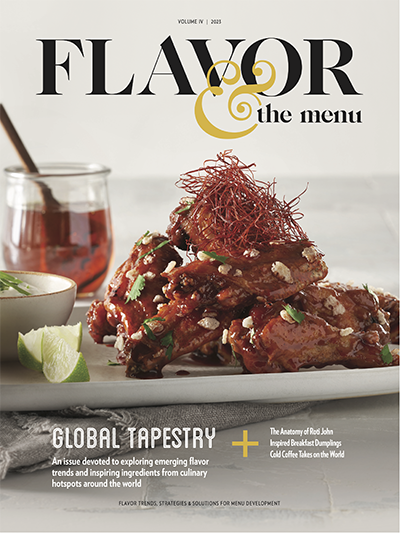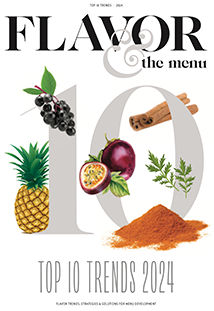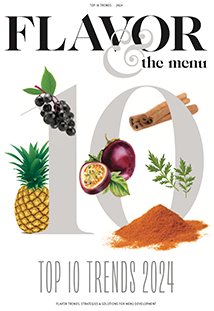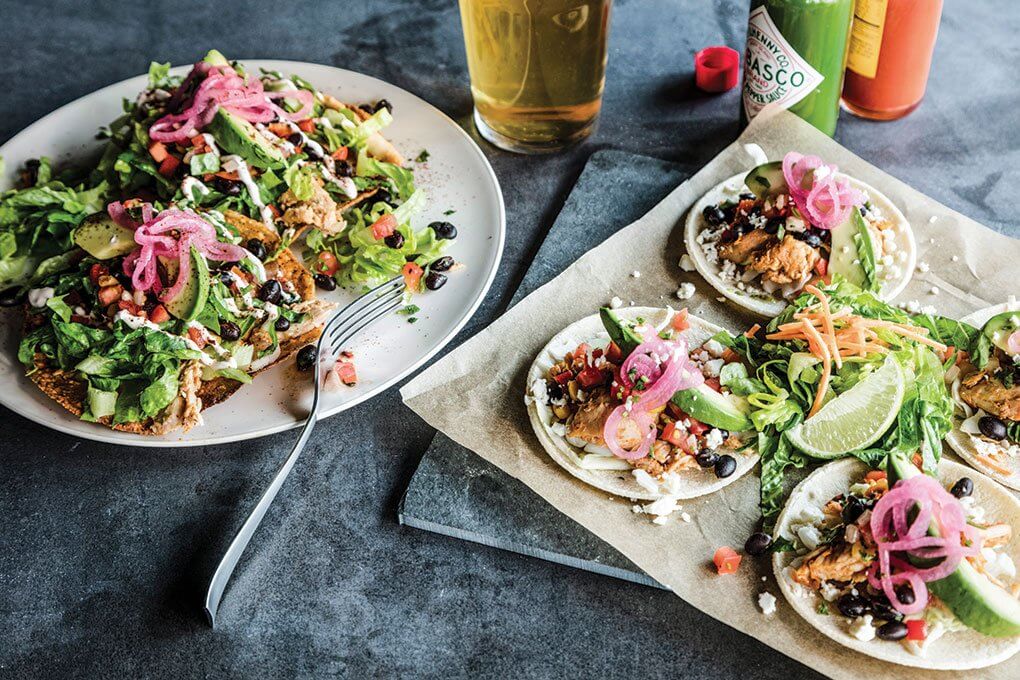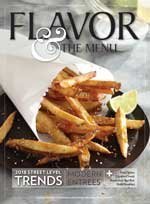There’s a breathtaking amount of innovation on menus today, with much of it focused on small plates and shareables. And with good reason — the social, clockless menu is a game-changing trend that’s here to stay. There’s also a lot of flavor strategy being applied to the modern bowl build, which captures what today’s diners want to eat — a satisfying, often wholesome presentation with layers of thoughtfully assembled flavorful ingredients.
But the entrée category is still a significant part of the menu mix for most full-service restaurants.
How is innovation in other parts of the menu affecting modern entrée development? How are shifting consumer demands impacting the evolution of what an entrée looks like?
Plate design has certainly always been dynamic, but those factors are putting pressure on chefs to rethink the composition of the plate and develop more flavor play, more textural elements.
“When we’re looking at the entrée platform on the menu, we have to keep in mind that we’re a mainstream brand,” says Stan Frankenthaler, chief officer of food and beverage, brewing and strategic supply for CraftWorks Restaurants & Breweries, Inc., which operates Rock Bottom Restaurant & Brewery, Gordon Biersch Brewery Restaurants and Old Chicago.
“Part of the strategy is the approach to menuing—how we want to continue placing entrées on our menu and evolve the menu as we go. Modern entrée building is absolutely built around flavor complexity—we’re going for big flavor pops and big visual appeal.”
Shifting From The Traditional Entrée
Traditional entrées generally follow a formula of a protein-centric build, with a starch and vegetable as support. Of course, a world of creativity can happen within that construct — and has for years — but today, there’s a shift in balance and makeup.
“It’s a more thoughtfully curated plate that still delivers on the promise of an entrée,” says Pam Smith, RDN, an Orlando, Fla.-based menu developer and culinary consultant, and co-chair of the Healthy Menus Collaborative. “The strategy today sees next-level plating, where protein is still the star, but beautifully prepared vegetables, pulses and grains become the co-stars.”
There’s evidence of this modernized model across foodservice, where changing consumer demands help fuel thoughtfully constructed offerings.
At Firebirds Wood Fired Grill, based in Charlotte, N.C., the new spring menu features Lemon-Basil Grilled Salmon with a lemon-basil vinaigrette and a cool salad of organic red quinoa, pearl barley, spring peas, toasted pecans, grilled corn and goat cheese. “Our strategy around dishes like this is to bring multiple components to the plate that feature seasonal produce and appealing flavor combinations,” says Steve Sturm, corporate executive chef. The attention to flavor detail that marks other parts of the menu has become an imperative with entrée development.
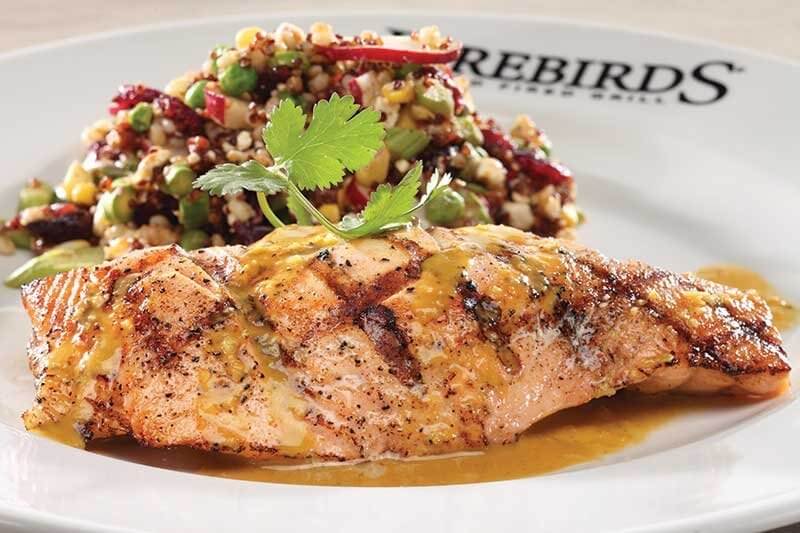 Firebirds Wood Fired Grill
Firebirds Wood Fired Grill The Lemon-Basil Salmon at Firebirds Wood Fired Grill buddies up to a flavor-forward and distinctive cool salad of organic red quinoa, pearl barley, spring peas, radish, toasted pecans, grilled corn and goat cheese.
Keeping The Value Proposition Intact
The challenge in retooling the entrée’s plate composition is keeping the value proposition intact. Diners have set expectations around entrées, wanting them to be satisfying and filling, and worth the typically higher price point than most other menu parts.
“A big part of the new approach to entrée development is around reducing the portion size of the animal protein while increasing vegetables and grains,” says Marie Molde, RD, account manager with Datassential. “They’re paying for it, though, so they still want a larger serving size—around six or so ounces is the sweet spot.”
The research firm’s latest data demonstrates that many consumers are open to an updated plate composition.
“Based on this research, diners are telling us that they are interested in more plant-based foods and are open to smaller portion sizes of animal protein, but that premium attributes become even more significant,” she says.
“Terms like ‘grass-fed,’ ‘antibiotic free,’ and ‘wild-caught’ carry an added level of importance to consumers when you’re giving them even slightly reduced portion sizes.”
Smith agrees, pointing to sourcing as a pathway to keeping the value proposition intact. “Tell your guests about the quality of the protein you’re serving in these modern entrées,” she says. “The ones that truly sing in this new symphony of ingredients are thoughtfully raised, mindfully sourced—proteins with a good narrative behind them. A good example here is Australian lamb, which is pasture-raised and grass-fed, two terms that resonate with today’s diners.”
Quality Over Quantity – Balancing The Equation
That principle of quality over quantity is not new in foodservice, and has been influencing the definition of value for a number of years now. With entrées, the imperative to get that equation right is crucial, balanced against the built-in expectation of a larger-sized dish.
What does value look like to modern consumers?
“Premium attributes help prove the value of a reduced portion of animal protein,” says Molde. “Another important part is pointing out the filling attributes of plant-based proteins, using terms like ‘protein-packed’ with quinoa or other whole grains on the plate, for example. This will help consumers understand the value better, addressing concerns that they might not feel full or get their money’s worth.”
Jamie Carawan, VP of food and beverage innovation for sports-bar chain Twin Peaks, based in Dallas, worked up an entrée that expresses all of these values really well: the Adobo Crusted Skirt Steak, a grass-fed steak with smoked ancient grains, summer sauté of sweet corn and grilled okra, roasted vegetable purée and toasted chickpeas.
“We went with a smaller portion of meat, six ounces, focusing on quality there while making the vegetables and grains the heroes, too,” he says. “There is a lot of attention to detail in this dish, making sure we still get high satisfaction from our guests.” And the build is still very much connected to Twin Peaks’ brand — another important consideration when exploring new strategies.
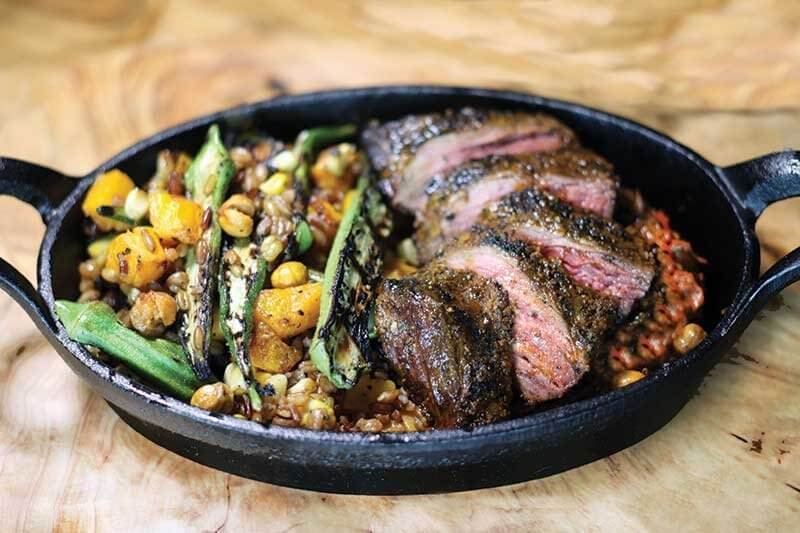 Twin Peaks
Twin Peaks Twin Peaks’ Jamie Carawan is developing an Adobo Crusted Steak, a modern entrée with no trade down: six ounces of grass-fed beef, smoked ancient grains, sauté of corn and okra, roasted vegetable purée and fried chickpeas.
Forwarding the Brand
That notion of brand tie-in guides much of menu development, and can also help set guardrails.
“At CraftWorks, we have advantages within our brands that start with the idea of crafted experiences around beer and food,” says Frankenthaler. “That’s our point of difference, but we still serve a broad audience. Our guests are mainstream diners seeking safe but differentiated experiences.”
His challenge with entrée development, then, is a similar one faced by a large number of restaurant brands wanting to remain competitive.
“Our guests want us to give them something unique to our brand that doesn’t stray too far from familiar,” he says. “With that in mind, we’re working through how to evolve. On the entrée side, it feels important that we move toward the lighter side.” That “lighter side” typically translates to fewer calories. The challenge is making those lighter options offer value and appeal to the majority of guests who aren’t necessarily looking to “be good.”
“The success of those dishes has to live beyond stereotypical constituencies of diners who order specifically around gluten-free or Paleo, etc. We have to hang on to who we are as a brand while moving the brand forward,” says Frankenthaler.
He’s doing that with dishes that boast both broad appeal and a wholesome promise. Rock Bottom’s Voodoo Ahi, a limited time offering (LTO) rolling out later this spring, captures the idea of flavor complexity and value, with spicy seasoned ahi tuna steak, seared and served over seasonal char-grilled vegetables with red rice, then topped with warm vodka-jalapeño salsa, crispy tortilla strips and fresh lime.
The Citrus Steak, another upcoming LTO, features a 5-oz. citrus-marinated steak, char-grilled and topped with whiskey and citrus herb sauces, served with char-grilled seasonal vegetables and cilantro-lime rice. “The five-ounce size gives the steak-eater a nice portion with good satiety and great flavor,” he says.
He’s positioning these LTOs in the mid-range of pricing for entrées.
“There’s big visual appeal with these, with components that add complexity of flavor, texture and aroma. The value perception is important, so we don’t run it in the highest price-point part of the menu.” That perception — where value is conveyed through quantity — is also shifting, guided by consumer preference and demand.
“Guest behaviors and preferences are changing, so it’s important to keep an eye on your current loyal guest while trying to reach for new ones—but understand that your current guest is changing too,” says Pam Smith.
Datassential’s Molde agrees: “The latest research shows that consumers are looking for a carefully balanced dish, with less animal protein and more interesting combinations of grains and vegetables.”
Modern Entrées Must Tell A Compelling Flavor Story
It’s not a surprise that flavor needs to stay in sharp focus here. Modern entrées have to tell a compelling flavor story that fits into the way diners want to eat.
“We can’t just concentrate on the center of the plate with entrée development,” says Firebirds’ Sturm. “All of the components need to be compelling — there’s no solo star anymore. And when you pay attention to each element, you really elevate the dish.”
Firebirds’ Guajillo-Mocha Rubbed Lamb Chops with a red quinoa and spring vegetable pilaf, ancho demi, pumpkin-seed pesto and an avocado-coconut-lime popsicle illustrate the modern sensibility.
“We rubbed the Aussie lamb with guajillo, cocoa and coffee, applying layers of flavor to the dish and featuring an emerging chile for added interest,” he says. “We don’t need to serve a huge portion of lamb because it’s rich, but you still need to present a full plate.”
The grains in the dish help add dimension. “We’re looking at grain salads to help us with entrée development because they let us feature seasonal products and help us get different textures on the plate,” says Sturm.
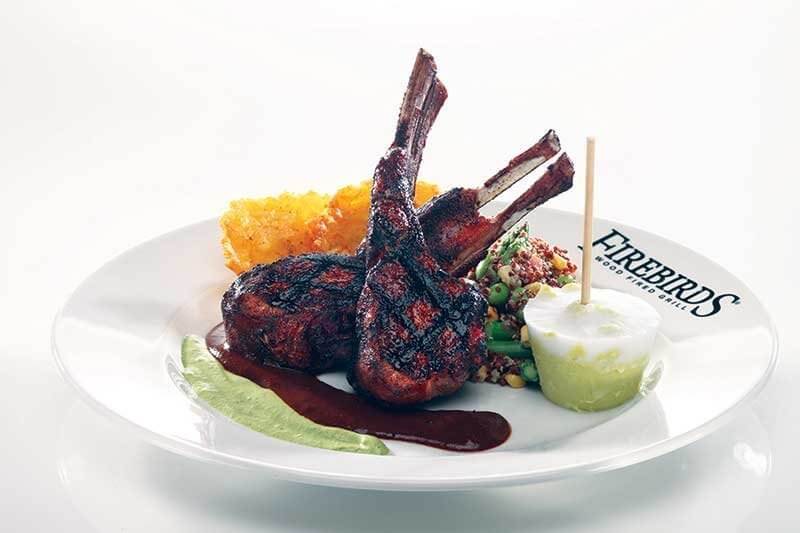 Firebirds Wood Fired Grill
Firebirds Wood Fired Grill Firebirds Wood Fired Grill’s Aussie Guajillo-Mocha Rubbed Lamb Chops entrée demonstrates a modern approach, with flavor punches throughout the build, including a pumpkin-seed pesto and ancho demi.
Adding Value Through Thoughtful Flavor-building
That complexity of flavor and texture goes back to the all-important value proposition. “It’s about adding value through thoughtful flavor-building and sourcing,” says Eric Stangarone, founder of Food Thinking, a food innovation consultancy in San Francisco. “It’s still about adding more seasonality, more heirloom, more niche products. You have to tell a story with your food.”
That translates into serious attention to detail.
“The quality of each component has to deliver, so we’re working harder on the composition of the entrée,” says Frankenthaler. “We’re throwing chickpeas into kale-quinoa bases for some of our entrées, or trying to get bigger flavor by basting with a thinned down pesto or beer sauce. We’re flipping the starch/vegetable ratio. It’s much more intentional, much less ‘veg of the day.’”
Sturm agrees with the need for an elevated flavor narrative, as demonstrated in his Pacific Halibut, another spring LTO, served with cauliflower mash and sautéed asparagus with a lemon-caper butter sauce drizzle. “We’re playing with cauliflower a lot,” he says. “We’ve got a Sriracha-honey cauliflower taco in one market test right now.”
At Rock Bottom, an entrée offering of Smoked Chicken Tostadas is a thoroughly modern dish with layers of flavor, featuring pulled chicken, pepper Jack and grilled onions, topped with guacamole, romaine, black bean-corn salsa, pico de gallo, pickled red onion and Mexican crema. “It’s been a top seller since we introduced it,” says Frankenthaler.
Thoughtful Menu Strategy
Thoughtful menu strategy is so important, with consumer expectation at an all-time high.
“Operators have to continue to think about their entrées as a portfolio of options that offer flavor excitement and variety while linking to the brand,” says Stangarone. “They could also consider either doing large-format entrées designed to share or serve family-style. Think about the theater in a whole roast chicken served in a cast-iron skillet for a few people to share—that delivers big perceived value.”
Designing modern entrées that can stand toe-to-toe with the other innovative parts of the menu helps give your guests another reason to visit. “We’re in a battle for share,” says Frankenthaler.
“Modern development of the entrée is around appeal and purchase intent, and knowing your guests and capturing new visitors. The lead for this is big flavor.”

